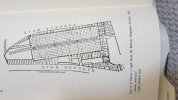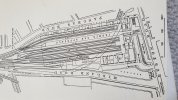The original intention at the lower level was to retain the Barlow column/girder/plate structure almost in its entirety. As is well known, the ceiling level of this undercroft provides the tie for the roof-arch, and so its integrity has to be preserved. Barlow was far-sighted enough to realize that platform layouts would change over the lifetime of his station, and so he designed the ceiling level of the undercroft as a horizontal deck structure to carry the track beds, with platforms built up off it. The platforms, originally in timber (Fig 10), are therefore not part of the primary structure.
Investigations showed that although the cast-iron columns and their foundations are in excellent shape and perfectly fit to be reused, the strength of the horizontal beams was questionable, in terms of maximum load-bearing capacity and expected lifespan. Additionally, improved vibration isolation was necessary between the platforms and the undercroft space below.
The chosen solution was to cast a new concrete deck across the full width of the station on top of the existing deck, so that its load is transmitted directly onto the columns (Figs 12 & 13). Such a concrete structure has large in-plane stiffness, unlike the existing beam grillage. This allows large holes to be designed into it, allowing the levels to be opened up.




